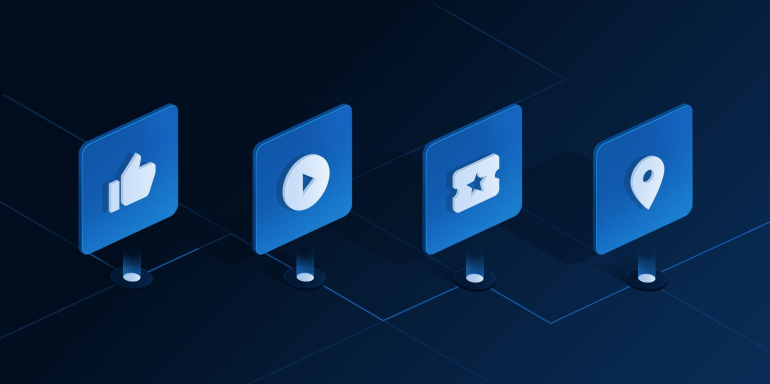You know that proving ROI is the only way to get a bigger budget from managers and more revenue from clients, but there’s a reason it’s still one of marketers’ biggest challenges:
There’s just too much going on between the click and the sale: a barrage of page variations, firing pixels, instant auctions, and behavioral triggers.
It’s controlled chaos you can’t see.
Even with a digital toolbox stocked with modern software, the journey is tough to track. One tool says one thing, another tool says something else. So what are you supposed to believe?
What is ad attribution?
Ad attribution refers to the process of determining the user actions that led to the desired outcome between the click of the ad and the conversion.
If you generated a sign-up, attribution is about retracing your new lead’s steps with tools to figure out where they came from. With that knowledge, you can determine your most and least profitable channels.
Why marketing attribution is so challenging
Marketing attribution is about discovering where you’re succeeding, but the tools designed to help you do it aren’t always as helpful as you’d hope. Many will use a different attribution model to report your ROI, like first or last-touch, which will tell you different stories of where your lead came from. And a lot of the time, those stories don’t span the entire customer journey to help marketers connect all the dots. Brad Thompson, Product Manager at Instapage, explains:
For instance, marketers know the CPC for a particular ad campaign in Google Ads. They know the conversion rate on a particular post-click landing page in Instapage. And downstream in the marketing funnel, in Salesforce, perhaps, they know the rate at which their sales team converts leads into sales. But there has been no cohesive way of putting those pieces of data together because they have not been passed along from the beginning to the end of the funnel.
The CPC for a visitor to the initial ad campaign is completely unknown to the sales representative by the time that visitor has become a lead because the tools haven’t been talking to one another and sharing that kind of data.
The types of marketing attribution
Online, there are two major categories of attribution models: single-touch attribution and multi-touch attribution. To help illustrate single-touch attribution, we borrowed a helpful and amusing Oscar analogy from Segment, which we’ll get to in a second.
First, a quick definition:
What is single-touch attribution?
Single-touch is a category of attribution that gives credit to only one of the sources of your conversion goal. Within this category are two types of single-touch models:
First-touch attribution
Using this type of attribution model, your tool will credit the first prospect touch point on the way to conversion. An actor using this model would credit the person who started them on the road to acting (hi, mom!).
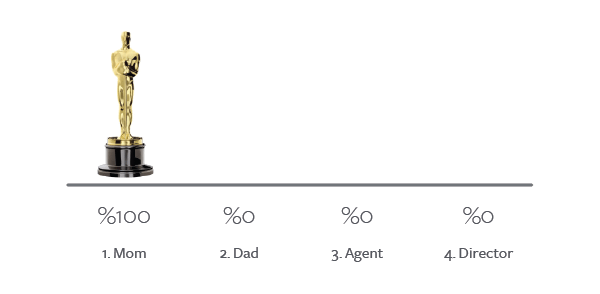
A variation of this model is first lead conversion attribution. When you use it, the channel that first turned your anonymous visitor into a lead will be credited.
Last-touch attribution
With this type of attribution model, your tool will credit the last user touch point before the conversion. An actor using this attribution model would credit the last person to help them win the award:
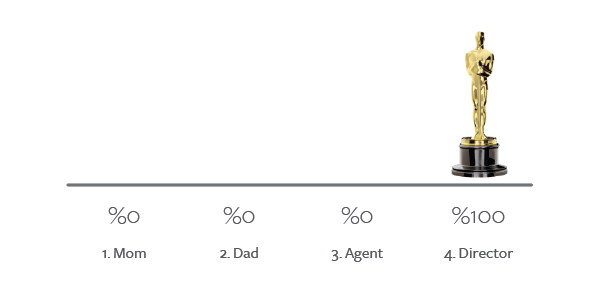
A few variations of last-touch attribution are:
- Last non-direct touch attribution: “Direct” traffic refers to anyone who arrives to your website by typing in its URL. But most times, people aren’t going to type in your web page URL to convert. What’s more likely is that they visited a post-click landing page a few days or weeks ago, then abandoned it. Then, they decided they did actually want to claim your offer, and they returned to the page by typing it in with the help of their internet browsing history. When you use this method of attribution, an analytics tool will tell you the last stop your prospect made before they converted.
- Last custom channel attribution: This method of attribution is helpful to specialty marketers. If you’re a Google Ads manager, you might want to discover the Ad source that leads to most sales opportunities. If you’re a social media manager, you may want to discover which social source leads to the most sales opportunities. Last custom channel attribution can help you discover what those sources are.
An example of single-touch ad attribution:
With an example, let’s take a closer look at how these two attribution models would give credit to channels in your customer journey.
Say your prospect, John Doe sees an ad for your company’s email marketing tool on Twitter.
He clicks it, and it directs him to a targeted post-click landing page where he pokes around, but ultimately decides not to convert because your click-through post-click landing page aims for the sale, and he’s not ready to buy yet.
Luckily, your retargeting strategy is tighter than your post-click landing page copy, so even though you didn’t earn a conversion this time, you cookie John. The next time he reads the news on his favorite publisher’s website, he sees another ad for your tool.
He clicks through, but still, he’s not convinced. He’s still at the top of your marketing funnel, in the early research stage.
For the next few days, he does some reading up on email marketing tools, and when he logs into Facebook the next week, he sees an ad for an ebook from your company on the best email subject lines. He claims it by trading his name and email address.
And with that personal information, you’re able to start a lead nurturing initiative. Over the next few weeks you send John targeted messages filled with valuable information that prove your authority, and eventually, a month later, he becomes a customer after clicking through an email offer.
A tale of two attribution models
John’s path to becoming a customer is obviously not simple or linear. He sees your offer first on Twitter, then on the Google Display Network, then a different offer on Facebook, and then many other offers via email once he becomes a lead. These are all stopovers on his way to the purchase.
If you were to give credit to just one of these channels, which would it be? Google Display Network? Twitter? Facebook for helping you generating the lead? Email?
First-touch attribution would give 100% of the credit to Twitter for the purchase (first lead conversion would give credit to Facebook). Last-touch attribution, on the other hand, would give all the credit to email for the purchase.
But neither of those models seem fair, do they? Each channel contributed to the purchase.
- Twitter generated the awareness and helped you cookie John.
- Google Display Network, even though it didn’t create a conversion, kept your brand top-of-mind.
- Facebook got you John’s name and email address.
- Email educated John and eventually directed him to a sales page where he became a customer.
Single-touch attribution gives only a fragmented view of the customer journey. And that’s why, today, most businesses rely on multi-touch attribution for a cohesive view of the channels creating the most success.
What is multi-touch attribution?
If single-touch attribution gives businesses a snapshot of the customer journey, multi-touch offers something closer to a flipbook. With several different models, multi-touch attribution can show the value of all channels along the path to purchase. For example:
- Which channel generated prospects’ awareness of your brand.
- What medium was responsible for creating the opportunity to start a lead nurturing initiative.
- Which source closed the sale.
Using the same Oscar analogy, Segment’s team does a great job of breaking down how multi-touch attribution works:
You can think of multi-touch attribution as a set of rules that give variable credit or “weight” to different marketing channels. Or, more mathematically, it can be considered as an equation where one side has the customer’s touch points as cost per impression and its different weight; on the other end should be the conversion value (e.g., the value of a Sign Up for your business).
For the Oscars, this means that you would thank multiple people for your award — your parents, your agent, your director, etc. However, what you say about each person you are thanking (giving them a tiny shout out vs. providing a more extended tribute) equals to the weight of the credit you’re giving them.
But who do you give a quick shout-out to, and who do you write an extended tribute for? That’s the question you’ll have to answer to determine which model of multi-touch attribution is right for your business.
Linear attribution
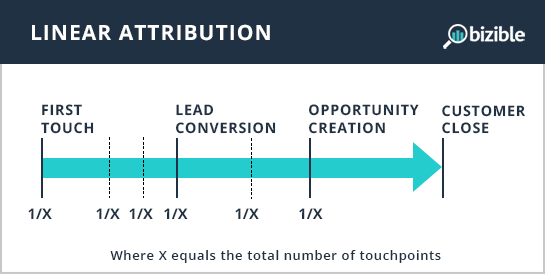
Linear attribution is the most basic of the multi-touch attribution models. There’s nothing all that fancy here. What you’ll see when you use this model is equal credit given to all channels involved in the conversion.
If we’re thanking people at the Oscars, everybody gets an equally long shout-out: mom, dad, agent, director, etc. If we’re bringing it back to John and his experience with your email marketing tool, Facebook, Twitter, email, and GDN all get equal credit for the conversion.
The biggest issue with that is, your mom and your agent probably don’t deserve equal credit (at least, not if you ever want home cooking again). And while GDN helped keep your brand top-of-mind when John was reading his favorite publisher, it didn’t do as much work as Facebook or email when it came to closing the deal. So, your view of the most valuable channels here is a little distorted.
Time decay attribution
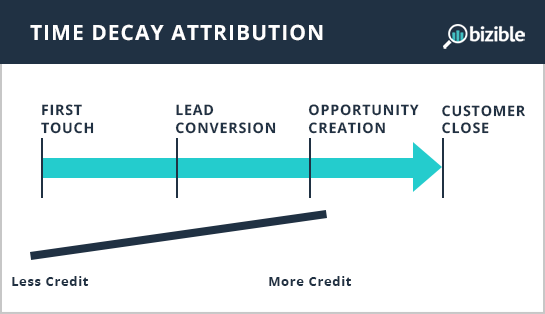
If you’re giving an Oscar speech, this model says, “You should thank your director most because she’s the one who gave you the opportunity to win an Academy Award in this movie.”
It assumes that the closer the channel is to the sales opportunity, the more responsible it is for the customer close. For John, that channel would be email because it’s what ultimately led him to purchase. If you retrace John’s steps from purchase to awareness, credit is given in descending order by analytics using this model.
Position-based attribution
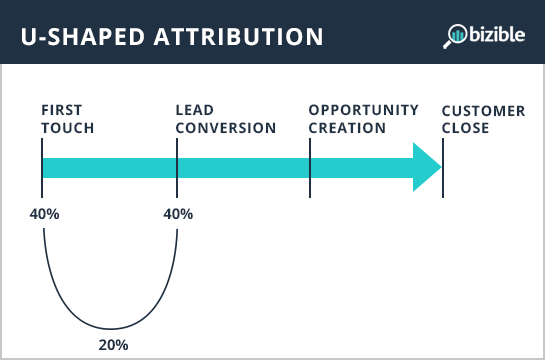
Google calls it “position-based,” Bizible calls it “U-shaped.” Whatever you want to call it, this model gives most of the credit to the first touch and lead conversion — 40% each — and then the remaining 20% is split among the channels that come after.
This model is Leonardo DiCaprio’s acceptance speech for best actor in the Revenant, in which he gives his mother a long tribute, along with the director of Titanic who offered him his first big break.
For John, Twitter and Facebook get the most credit because they introduced him to your tool and turned him into a lead.
The downside of this model is that it gives little credit to any bottom-funnel effort. As a result, it’s used mostly by marketing agencies without sales teams who are in charge of generating awareness and leads on behalf of clients.
W-shaped attribution
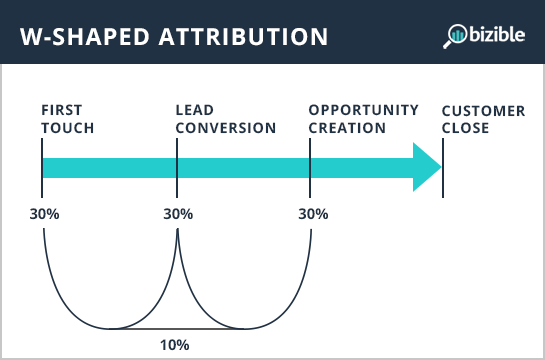
This model is similar to U-shaped attribution in that it gives credit to the first and last touch, but it also acknowledges the importance of the opportunity-creating source. First touch, lead conversion, and opportunity creation each get 30% of the attribution, and the rest of the customer touch points get an equal split of the remaining 10%.
Oscar in-hand, up at the microphone, this is you thanking mom, the person who offered you your big break, and the director of the movie in which you won the Academy Award (sorry, dad).
For John, credit goes to Twitter, Facebook, and Email for the purchase (sorry, GDN).
Z-shaped attribution
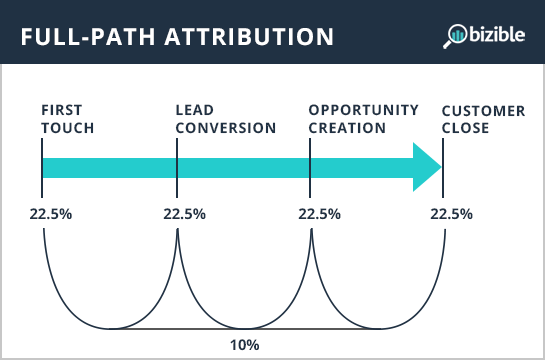
This model gives equal attribution to all four crucial stages of the journey: first touch, lead conversion, opportunity creation, customer close. They all get 22.5%. The other 10% is distributed equally among any other touch point there may be.
At the Oscars, this is you thanking mom (first touch), whoever gave you your big break (lead conversion), the director of the movie you won the award for (opportunity creation) AND the producer for creating that movie (producer). Because without him, there wouldn’t be a finished product.
The remaining 10% of shout-outs would go to all the actors that you co-starred with, and maybe even your grade-school drama teacher for giving you the lead in Hamlet.
For John’s conversion, 22.5% of credit would go to Twitter, Facebook, email, and whichever post-click landing page variation converted him. 10% would be given to GDN.
Which ad attribution model is right for your business?
So, who should you be thanking at the Oscars? There’s no right answer.
According to Bizible, it’ll involve answering a lot of questions like:
- Am I B2B or B2C?
- How many marketing channels do I use?
- Do I have a sales team?
- How long is my sales cycle?
They’ve put together an easy-to-understand flow chart to help you figure it all out.
At Instapage, we’ve put together something to make your ad attribution easier, too. It’s the new Advertising Attribution Solution, which allows you to integrate all your Google Ads data with Instapage so you can see not only essential Google Ads KPI’s like CPC and CTR but also how much each lead and conversion is costing you by connecting all touch points between the click and the final sale.
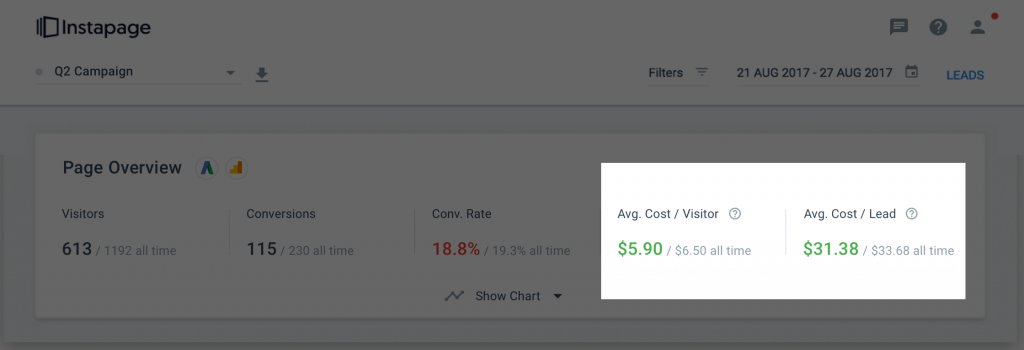
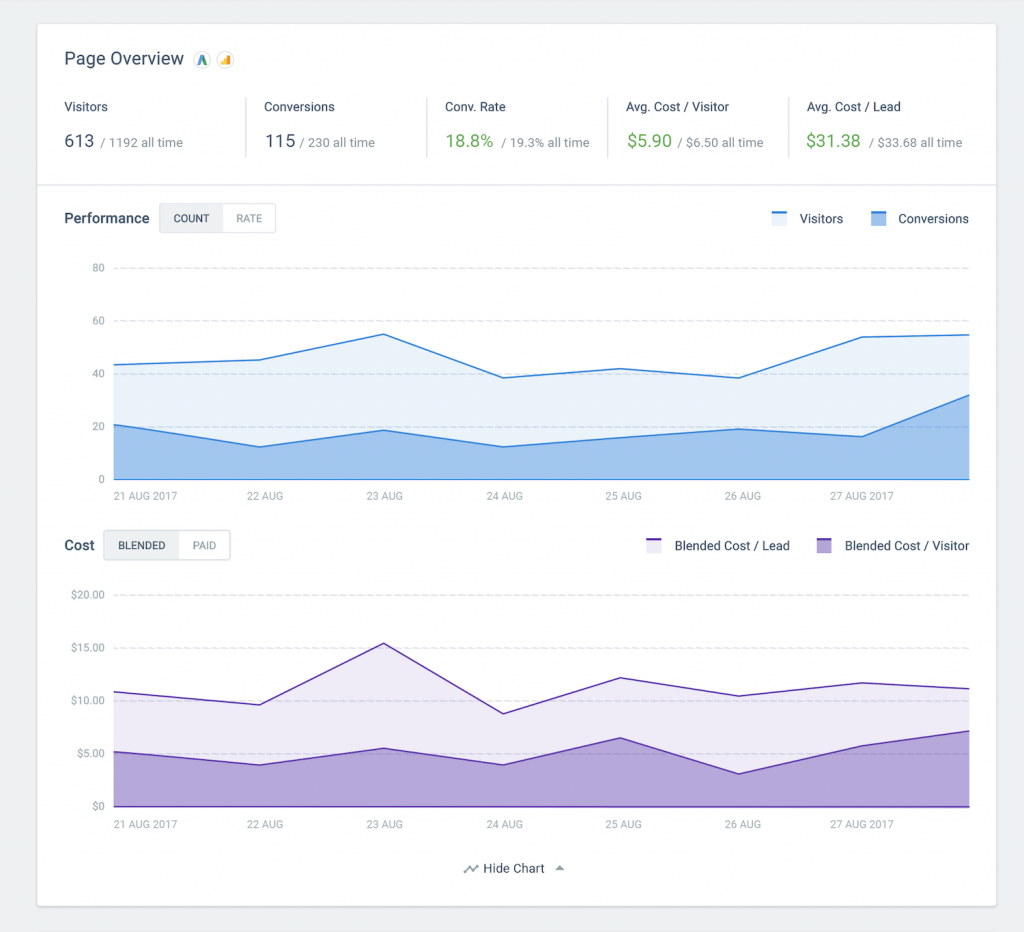
With it, you’ll be able to discover your best-performing combination of ad and post-click landing page. Brad explains:
Armed with attribution data, digital marketers may learn that ads previously thought to be performing well by generating high quantities of leads may be revealed in fact to be generating low-quality leads that don’t convert to sales. Conversely, ads that appeared to be poor performers by lead volume may be shown to be more efficient because their cost per lead is lower. These insights can allow digital marketers to optimize their ad spend and thus spend their advertising money more efficiently.
Ready to get started with better ad attribution? Sign up for an Instapage Enterprise demo today.

See the Instapage Enterprise Plan in Action.
Demo includes AdMap™, Personalization, AMP,
Global Blocks, heatmaps & more.
